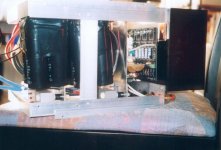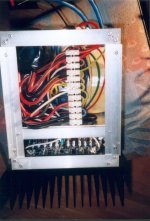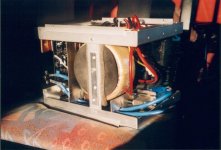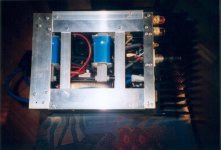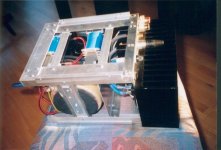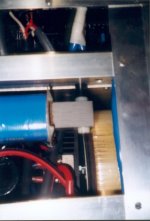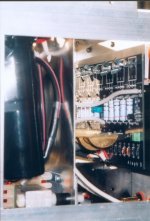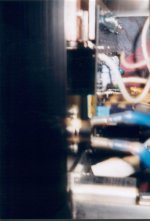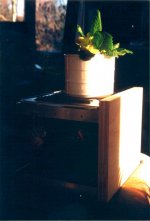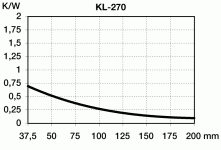I have finally got some pictures of my two new Aleph 5 monoblocks.
They were taken some 10 days ago when I had just started to listen to them.
You will see them in their naked version.
Meanwhile I have added the wooden sides and the aluminium tops and bottoms. The frontplate will be professionally made in a later stage.
Lucas.
In this picture you see the side of it:
The Condis were still not fixed, but hey cvould not fall out...
They were taken some 10 days ago when I had just started to listen to them.
You will see them in their naked version.
Meanwhile I have added the wooden sides and the aluminium tops and bottoms. The frontplate will be professionally made in a later stage.
Lucas.
In this picture you see the side of it:
The Condis were still not fixed, but hey cvould not fall out...
Attachments
These PCBs are Kristijan's...
I attached folded brass dog-pennings for cooling the 9610s.
Under the PCBs you first get a nylon ring, then an alunminium stripe, then the IRFP 240, then Kapton (non-grease) isolation, then a 3 mm thick redcopperbar, then grease, and finally the Seifert Heatsink, measuring 216 x 150 x 84 mm.
I attached folded brass dog-pennings for cooling the 9610s.
Under the PCBs you first get a nylon ring, then an alunminium stripe, then the IRFP 240, then Kapton (non-grease) isolation, then a 3 mm thick redcopperbar, then grease, and finally the Seifert Heatsink, measuring 216 x 150 x 84 mm.
Attachments
Here is a final (rather dark) picture where you can see the wooden sidepanels in a still rough state and one of the aluminium grids for the tops and bottoms.
(They have been installed now but I don't have a digital camera. I will post them later...)
(They have been installed now but I don't have a digital camera. I will post them later...)
Attachments
Some remarks on the components used:
The toroids are 30 VAC 330 VA from Reichelt, Germany. Very cheap (33 Euro) and very silent.
The Condensators are 45 Volt (56 Volt surge) Marcon 16.000 uF. I used 2 sets of 4 pieces in each monoblock, divided by Intertechnik 3,9 mH 0,24 Ohm I-Point chokes.
I use two rectifierbridges for each channel.
The 30 VAC result in a 39 VDC under load.
One channel delivers appr. 30 mV DC offset, the other one is around zero!
I matched all mosfets, and I also matched the 550BC on HFE.
I used 0.25 Watt 0,1% precision resistors made by Welwyn, and 5 Watt MOX resisters made by Intertechnik.
Since I too have 4 Ohm speakers I decided to use the resistorvalues of WuffWaff that he has posted in another thread. This leads to a higher bias.
The Seifert heatsinks reach a temperature of about 47 degrees Celsius at a roomtemperature of 20 degrees. The redcopperbar on which the mosfets are attached reaches 53 degrees.
We can therefor conclude that the redcopperbar is a good solution.
Now on to the sound:
I have borrowed a lot of commercial products in the 1000 up to 4000 Euro segment from a befriended Hifi-shop.
Most sounded horribly clean and sterile with a narrow spacing.
Only a Classé Audio amp was a bit more natural but its bass was weak.
The Aleph 5 is in another class: it lets you hear detail and space in recordings without ever getting harsh.
It is the most natural sound that I have heard.
Thank you Nelson Pass!
Regards to all,
Lucas.
The toroids are 30 VAC 330 VA from Reichelt, Germany. Very cheap (33 Euro) and very silent.
The Condensators are 45 Volt (56 Volt surge) Marcon 16.000 uF. I used 2 sets of 4 pieces in each monoblock, divided by Intertechnik 3,9 mH 0,24 Ohm I-Point chokes.
I use two rectifierbridges for each channel.
The 30 VAC result in a 39 VDC under load.
One channel delivers appr. 30 mV DC offset, the other one is around zero!
I matched all mosfets, and I also matched the 550BC on HFE.
I used 0.25 Watt 0,1% precision resistors made by Welwyn, and 5 Watt MOX resisters made by Intertechnik.
Since I too have 4 Ohm speakers I decided to use the resistorvalues of WuffWaff that he has posted in another thread. This leads to a higher bias.
The Seifert heatsinks reach a temperature of about 47 degrees Celsius at a roomtemperature of 20 degrees. The redcopperbar on which the mosfets are attached reaches 53 degrees.
We can therefor conclude that the redcopperbar is a good solution.
Now on to the sound:
I have borrowed a lot of commercial products in the 1000 up to 4000 Euro segment from a befriended Hifi-shop.
Most sounded horribly clean and sterile with a narrow spacing.
Only a Classé Audio amp was a bit more natural but its bass was weak.
The Aleph 5 is in another class: it lets you hear detail and space in recordings without ever getting harsh.
It is the most natural sound that I have heard.
Thank you Nelson Pass!
Regards to all,
Lucas.
grataku said:Is it just me or the pictures? I have been looking at these for the past five minutes and I have almost no idea of how this amp looks or it's put together.
I had a good laugh reading your comments, which as usualy, are right to the point.
I also noticed unique way of mounting output devices, very practical.
So, it is nice.
grataku said:Is it just me or the pictures? I have been looking at these for the past five minutes and I have almost no idea of how this amp looks or it's put together.
It works, so very nice I guess.
Peter Daniel said:
I had a good laugh reading your comments, which as usualy, are right to the point.I guess too many close ups and not enough wide angle photos.
I also noticed unique way of mounting output devices, very practical.
So, it is nice.
Hi Grataku and Peter,
I already had this fear when I posted them...
 , but you DIY guys like puzzling, don't you?
, but you DIY guys like puzzling, don't you?I had a very simple camera at my disposal and the light conditions weren't very ideal, I guess.
I will make some more (and hopefully better) pictures with the sidepanels attached.
BTW, I thought that you DIY guys are more interested in naked photography than external cosmetics....
Anyway there seem to be no questions, so it can't be that much confusing. (Or it is too confusing to invoke questions...
Peter, I used 30 mm M3 bolts that went into the heatsink up to the maximum end. Then I could easily raise tension on the mosfets by turning the butterfly nuts. This way you can use the maximum available thread within the heatsink and it doesn't put pressure on the thread while turning around...
Anyway, thanks for all your attention!
Regards,
Lucas.
Taco said:And another Dutch Aleph is born. Your chasis is very different, but I think very rigid too. Are you using the amp balanced?
Hi Taco,
Yes it is very rigid. Aluminium is always a wonderful tool to play with, even if you have to do with L-profiles instead of the wonderful solid bars of Peter Daniel....

I have tried the amp both un- and balanced, however with my current preamp I get a somewhat better and more dynamic sound with unbalanced. Maybe the balanced outputs of my AVM evolution V3 are not so good. They also seem to have the same outputlevel as the unbalanced outputs...
I will built an Aleph P1.7 later. Maybe with that preamp the balanced inputs will sound better.
Regards,
Lucas.
Franz said:Hi!
I wonder how you manage to get only 47 °C at the heatsink with this size and 39 V DC rail voltage !?
Your heatsink seems to be pretty small.
Also I wonder if a 330 VA rating of the trafo is adequate.
However I beliefe you that all is working well.
cheers
Franz
Hi Franz,
I was also sceptical at first when I saw the diagram at
http://www.seifert-electronic.de/eng/prod/index_p.htm
When you look at it you find at 150 mm a C/W of 0.15
The heatdissipation in my Aleph 5 is appr. 2,4 x 39 x 2 = 187 watt per channel. The above room temperature is 47 - 20 = 27 degrees. 27 / 187 = 0.144
Therefor we can conclude that Seifert is quite honest in their value of 0.15 C/W
One of the secrets of this heatsink is that they have long cooling-fins that have an extra surface because they are curved.
Furthermore I have them some 5 cm lifted from the underground so that air can freely go through the "chimneys".
With a dissipation of 187 Watt you could also do with a 220 VA
transformator, provided it is of good quality. The 330 VA has enough reserve, especially if you consider that a good quality toroid can easily provide 1.5 up to 2 times the nominal value without going into saturation. A 500 VA won't hurt either of course, but that is up to you...
BTW: I tried also a 750 VA (which I will use for Aleph 2s) but I could definitly not hear any difference with the 330 VA type! (Not so good news for all those who spent money on oversized toroids, I guess...)
Regards,
Lucas.
Attachments
- Status
- This old topic is closed. If you want to reopen this topic, contact a moderator using the "Report Post" button.
- Home
- Amplifiers
- Pass Labs
- Aleph 5 playing...
